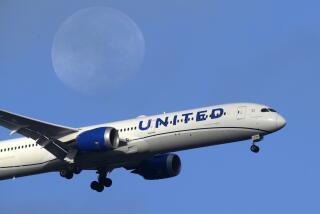The Next Wave? Surfing the Web at 35,000 Feet
- Share via
NEW YORK — For many busy people, an airliner is one of the last places with guaranteed down time, away from the tentacles of e-mail and requests from the office.
That’s about to change.
Several international carriers next year will begin offering high-speed Internet access via satellite. For now, it’s basically a trial run so the airlines can figure out how much people are willing to pay to get online with their own laptops at 35,000 feet.
This toe-dipping comes as several companies stand ready to upgrade airplanes with a range of improved communications systems, such as giving passengers the means to send and receive e-mail and instant messages at their seats.
Boeing Co. is set to debut its Connexion satellite broadband service Jan. 15 on Lufthansa flights from Frankfurt, Germany, to Washington-Dulles. Scandanavian Airlines System (SAS), British Airways and Japan Airlines are slated to try it next.
Lufthansa will offer the service free for three months; British Airways plans to charge about $30 per flight.
That price sounds about right to Rob Vollmer, 32, a principal in Crosby-Vollmer International Communications, a Washington-based public relations firm.
Vollmer, who has flown 140,000 miles this year, does so much work by e-mail that he sometimes feels compelled to surreptitiously check messages during flights with a wireless hand-held device, though it’s prohibited.
“If I could do so legally for a fee, I’d jump at the opportunity,” Vollmer said. “Going six to eight hours without the ability to send or receive e-mail is a form of torture,” he said, offering proof: He once took an unnecessary flight from London to India because he missed an e-mail saying that a meeting had been postponed.
Connexion’s service requires installing two antennas on the plane, one to transmit data to satellites and one to receive data. A server and routing system inside the plane relay signals to and from plug-in ports at the seats or wireless networking cards in passengers’ laptops.
The service promises speeds comparable to cable modems, with downloads up to 1 megabit per second. Even if everyone on board logged on at once, Connexion spokesman Terrance Scott said, the data transfer rate would not be less than 56 kilobits per second, comparable to dial-up.
Connexion eventually could use voice-over-Internet technology to let passengers make phone calls safely, Scott said. Mobile phones are banned in flight out of fear they could disrupt navigational systems and wreak havoc with cellular networks on the ground.
Boeing won’t disclose the cost of installing Connexion. But it is considered far more expensive than simpler systems for planes that store data on a server and periodically connect with ground networks rather than maintaining a constant feed via satellite.
One such option, JetConnect, a Verizon Communications Inc. system that already is available on some Continental and United Airlines flights, uses the same network as Verizon’s Airfones, those expensive handsets on seat backs.
For $5.99 per flight, travelers who hook their computers to JetConnect can play games, peruse certain Web pages that get updated every 15 minutes and send and receive AOL, Yahoo and MSN instant messages. Verizon plans to add e-mail in mid-2003.
Similarly, Tenzing Communications Inc., which is backed by Boeing rival Airbus, can provide e-mail access and short text messaging. Cathay Pacific, Varig and Virgin Atlantic are customers; Seattle-based Tenzing expects to sign several more in 2003.
Several airlines, notably American, Delta and United, said last year that they would buy Connexion’s service, but those plans evaporated after the terrorist attacks when mere survivability became paramount.
Now, some carriers are showing renewed interest in Internet services in hopes they can generate incremental revenue, improve customer loyalty and provide new perks in first and business class, said Rob Brookler, spokesman for the World Airline Entertainment Assn.
Indeed, several frequent fliers seem eager to sign up.
Avi Steinlauf, a vice president at Edmunds.com, an autos Web site, said he’d “easily pay up to $50 for broadband access on a cross-country flight.” Robert Brooker, head of ICLUBcentral Inc., a Cambridge, Mass.-based software company, said $20 an hour “seems like the right price point.”
Still, that sentiment might not be widespread. Tenzing is testing real-time satellite Internet connections but expects the market to lie in corporate jets rather than commercial aircraft, said Peter Lemme, Tenzing’s chief technical officer.
Low-cost carrier JetBlue could offer Internet access relatively easily by adapting equipment it uses to show live cable TV on flights via satellite. But JetBlue isn’t convinced the Web would be heavily used.
“People are much keener to watch ‘TV Land’ than draft proposals or write e-mails,” JetBlue spokesman Gareth Edmondson-Jones said. “It’s always been very politically correct to say, ‘Oh, I do all this work on the plane,’ but is that out of boredom? Wouldn’t you rather have a beer and watch ESPN?”
More to Read
Inside the business of entertainment
The Wide Shot brings you news, analysis and insights on everything from streaming wars to production — and what it all means for the future.
You may occasionally receive promotional content from the Los Angeles Times.










